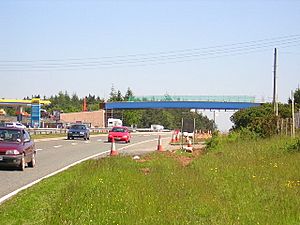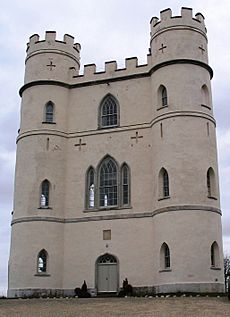Haldon Hills facts for kids
The Haldon Hills, often just called Haldon, is a high ridge of land in Devon, England. It sits between two rivers, the River Exe and the River Teign. The hills stretch north from Teignmouth on the coast for about 24 km (15 mi). They gradually get smaller north-west of Exeter, near the River Yeo. The highest parts of Haldon are over 250 metres (820 ft) tall. The southern part is called Little Haldon. It's partly separated from the main hills by a dip in the land.
Contents
What Haldon Hills Are Made Of (Geology)
Haldon is mostly made of a type of rock called New Red Sandstone. On top of this is a harder layer called Upper Greensand. The very highest parts have a thick layer of gravel, up to 18 metres (60 ft) deep, which contains many flints. This gravel is what's left of a very thick layer of chalk that used to cover the hills. Over millions of years, this chalk slowly dissolved away, especially during a time called the Eocene when the climate was tropical.
Around the highest areas, you can find other types of rocks too. Near Chudleigh, there are limestones from the Devonian period. Further north, there are shales, sandstones, and cherts from the Carboniferous period. Sometimes, these rocks are cut through by dolerite, which is a type of volcanic rock. People used to mine for different metals here, like lead, iron, copper, and manganese.
Amazing Nature (Ecology)
Three special areas on Haldon have been named Sites of Special Scientific Interest (SSSIs). This means they are very important for nature.
The biggest SSSI is Haldon Forest. It covers most of the high woodland north of the A380 road. This area is special because of its birds. It's a really important home for the European nightjar, with about 80 pairs nesting there. Six types of bird of prey also live and breed here. These include the rare European honey buzzard and the goshawk, as well as the Eurasian hobby, Eurasian sparrowhawk, common buzzard, and common kestrel.
Haldon Forest is also home to many butterflies, moths, and dragonflies. A total of 35 butterfly species have been seen here, including the rare high brown fritillary and pearl-bordered fritillary.
The other two SSSIs are Great Haldon Heaths and Little Haldon Heaths. These areas have a special type of lowland heath habitat that is only found in south-west England. You can find the Devon Whitebeam tree on Little Haldon Heaths. Also, rare plants like the Climbing Corydalis and the parasitic Greater Dodder grow here.
A Look Back in Time (History)
Haldon is one of the few places in Devon with signs of early human settlement from the Neolithic period, around 4000 BC. There are about 26 Bronze Age burial mounds, called tumuli, on Haldon. However, many more might have been destroyed because people often used the gravel and flints for building roads.
On Little Haldon, there's a probable Iron Age enclosure called Castle Dyke. It's a square area about 100 metres (330 ft) on each side and was a good place for defense. An old path called the Portway crosses Little Haldon and goes past this ancient earthwork.
The high ground of Haldon has always been a challenge for people traveling from Exeter to the south and west. There's some evidence of a Roman road that went over Haldon towards Newton Abbot. Later, in 1760, much of this route became a turnpike road, which means people had to pay to use it. Today, it's mostly under the A380 road.
You can still see several old, sunken lanes that climb Haldon from the east. These lanes, like Holloway Lane, were cut deep into the hillside, sometimes over 6 m (20 ft) deep, from centuries of use by people and animals.
Around Little Haldon, there are signs of about a dozen villages from the medieval period that are now deserted. One example is Seacombe. The ruins of Lidwell Chapel, probably built in the 13th century, can still be seen on Little Haldon. In the early 14th century, a hermit named Robert de Middlecote used it as a base and caused trouble for travellers. The chapel has a holy well, which legend says is bottomless.
In more recent times, Haldon became an important source of building materials like flint, gravel, and sand. You can still see small, overgrown quarries and pits that were used to get gravel for roads in Victorian times.
In 1928, Haldon Aerodrome opened on Little Haldon. It was a popular place for flying for fun. In 1939, it became part of an air service connecting Cardiff and Plymouth. During World War II, the military took over the aerodrome. It didn't reopen after the war, and today, there are only a few visible remains, like the old waiting room.
In the 1930s, during a time of high unemployment, young men worked in Haldon Forest. They cleared ground, built tracks, and did other hard labor. They lived in a work camp in the forest. These camps were set up to help young men who had been out of work for a long time. After the war, a prison called Haldon open prison opened on the site in 1949, but it closed in 1974.
Where the Name Comes From (Toponymy)
The exact meaning of the name Haldon isn't completely clear. It was first written down in 1281. Some experts think it comes from an Old English word meaning hail, perhaps because of a famous hailstorm. Others believe it might come from Old English words meaning look-out hill or holy, suggesting it might have been a special religious place long ago.
Travellers on Haldon
In 2002, a group of travellers moved into a picnic area near the racecourse. After discussions, a permanent legal site for travellers was opened in 2014. This site has 15 permanent pitches with amenity buildings.
Roads Across Haldon
Haldon Hills lie across the path of two major roads that lead into Devon: the A38, which goes to Plymouth and Cornwall, and the A380, which goes to Newton Abbot and Torbay.
The A380 has a very steep climb to the top of Haldon, known as Telegraph Hill. At the top of this hill, there used to be a dangerous crossroads called Haldon Chalets. To make it safer, a new bridge was built over the A380 in 2005.
Important Buildings on Haldon
There are several interesting buildings on Haldon. Oxton House is in a hidden valley on the eastern side. South of that is Mamhead House. Further south, on Little Haldon, is Ashcombe Tower. It was built in 1833 as an observatory, a place for observing the sky. Later, it was made into a home. On the very edge of Little Haldon, near Dawlish, is Luscombe Castle. It was built in 1800 by a famous architect named John Nash.
Haldon Belvedere
Haldon Belvedere, also known as Lawrence Castle, is a special triangular tower. It stands in a high spot on the hills, looking out over the Exe Estuary. This tower was built by Robert Palk to remember his friend, Major-General Stringer Lawrence. It's a well-known landmark that can be seen from far away. Today, it's open to the public and is also used for weddings and events.
Haldon House
About a kilometre north-east of Haldon Belvedere, at the bottom of the hills, was Haldon House. This house was built in the early 1700s. It was bought by Sir Robert Palk around 1770 and was visited by many important people, including King George IV and Guglielmo Marconi. Marconi, who invented radio, did some of his early experiments with radio signals from these hills. Most of the house was taken down in the 1940s. The part that's left is now the Lord Haldon Hotel.
Near here is a small group of homes called Dunchideock. Further north, on the same ridge, is Cotley Castle, an Iron Age hill fort.
Fun Things to Do (Leisure)
Haldon is heavily covered in trees, and a large part of its highest ground is owned by the Forestry Commission. This makes it a popular place for local people to go for walks, try orienteering (a sport using maps and compasses), and go off-road cycling.
At the highest point on the A38 is the Exeter Racecourse. This is a horse racing track that hosts the Haldon Gold Cup event every November.
On top of Little Haldon, you'll find Teignmouth Golf Club. The golf course was designed by a famous golf course architect, Alister MacKenzie. There are also several picnic spots, and the area is loved for its amazing panoramic views.





